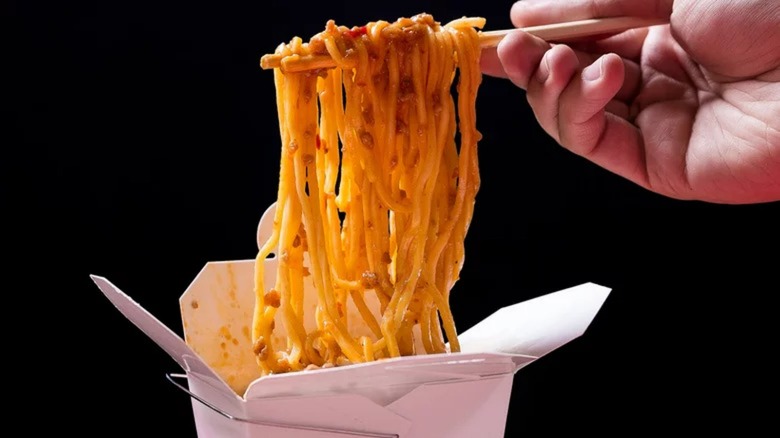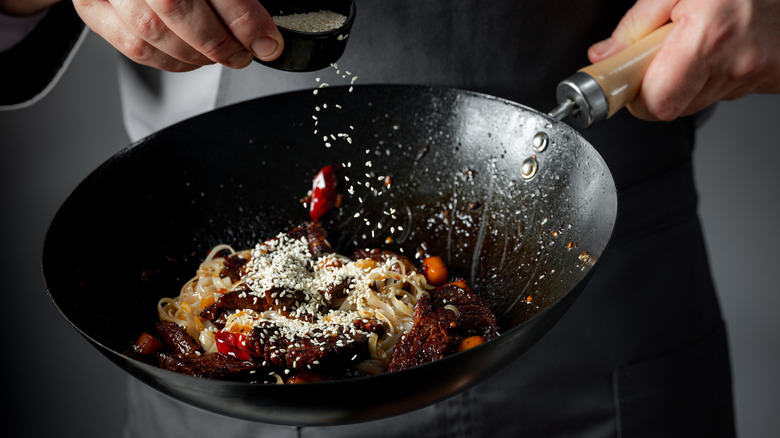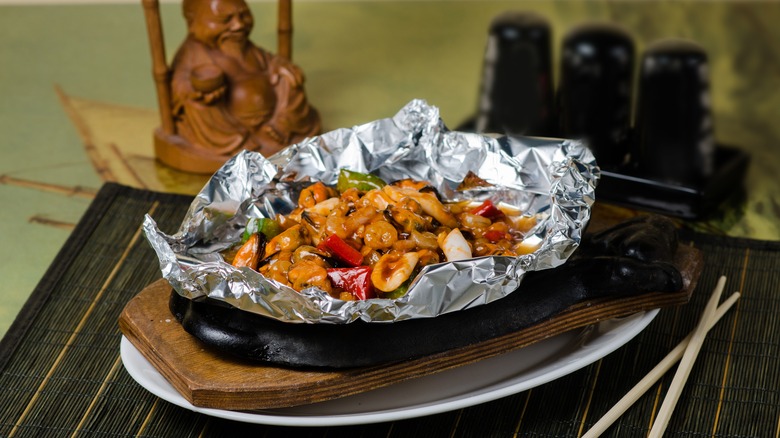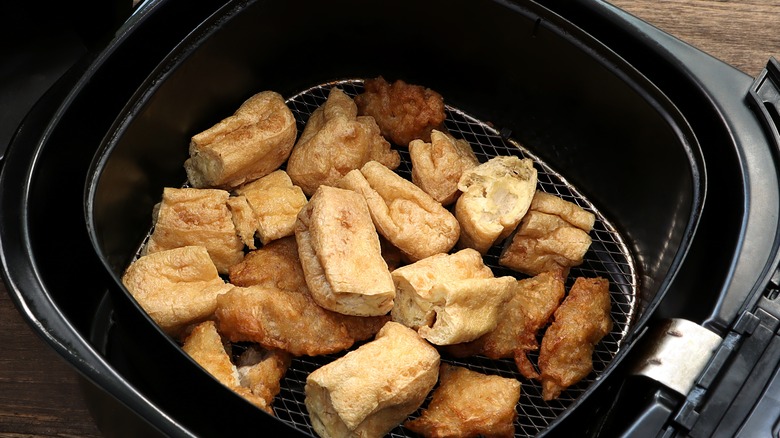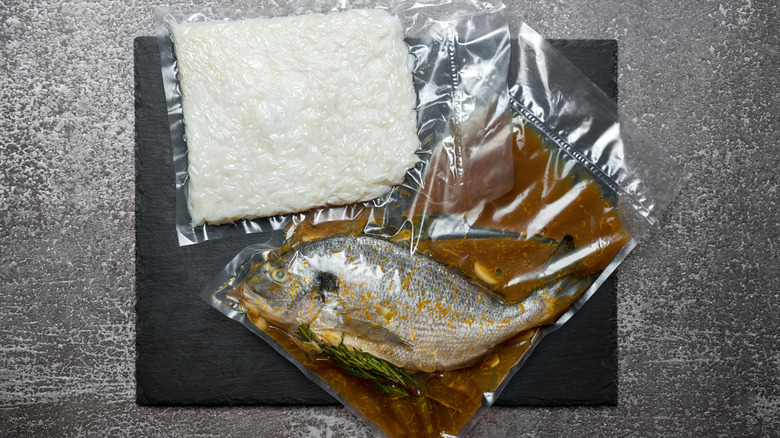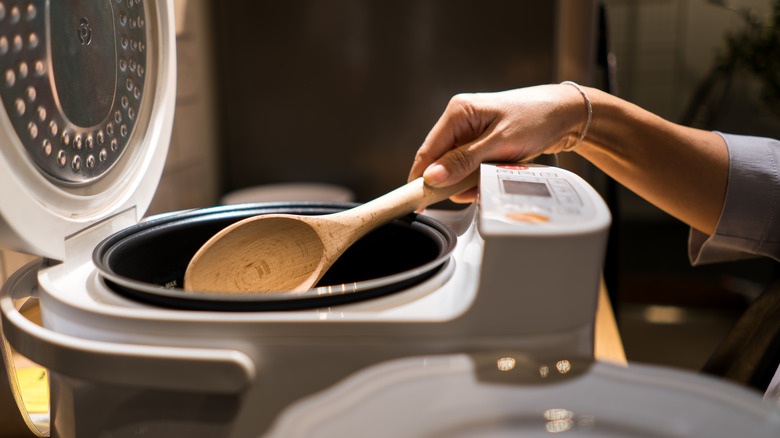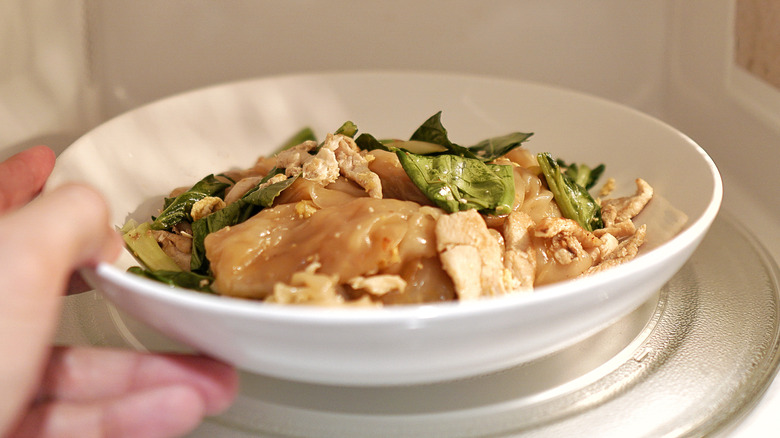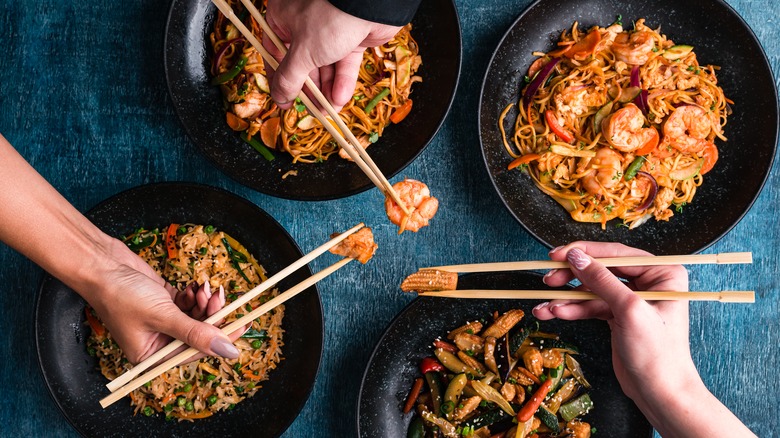The Best Ways To Reheat Chinese Food
We may receive a commission on purchases made from links.
Some say Chinese food tastes better the next day, and who are we to argue when science confirms it? Per Dr. Kantha Shelke of the Institute of Food Technologists, all those aromatic ingredients undergo some tasty chemical reactions while cooking, and these continue even after cooking stops. But tempting as it may be to grab your chopsticks and dig in by the light of the fridge, we don't recommend eating leftover Chinese without first reheating it.
First, to avoid foodborne illness, leftovers should always be heated to between 145 and 165 degrees Fahrenheit, depending on what's in those leftovers, according to the USDA's Food Safety and Inspection Service (FSIS). Because Chinese food may contain multiple ingredients with different minimal reheating requirements, however, your safest bet is to aim for 165. Moreover, the only way to know for certain if you've heated your food to a particular temperature is by inserting a food thermometer directly into the food (and a clean food thermometer, at that, please!). The exception is for sauces and soups, which the FSIS says are safe when reheated to a rolling boil.
As the FSIS points out, failing to reheat food to a safe temperature is one of the primary causes of foodborne illness. The other is leaving food out to spoil or otherwise storing it incorrectly. We'll be addressing best practices for storing your leftover Chinese food below. But first, let's take a look at what we think are the best ways to reheat Chinese food.
Frying pan or wok
"Using a stovetop to reheat your food allows you to rejuvenate the flavors as you can add in some flavors to your leftover Chinese foods like soy sauce, meat, egg, and veggies," writes the Chinese food blogger at Yum of China. And let's not forget sesame seeds, as shown above, and any number of steeped or infused oils, should you have them on hand. That being said, you can toss some of these rejuvenating flavors into your leftover Chinese food no matter which method you use for reheating. However, the advantage of reheating your Chinese food on the stovetop is that doing so allows you to taste and adjust in real-time, as you go.
To get started, Yum of China recommends setting the heat under your frying pan or wok to medium heat and then drizzling the surface with water, oil, or broth/stock. Once the surface is hot (the oil will shimmer, or the water/broth/stock will bubble and steam), add your leftover Chinese food, and stir constantly to prevent burning. If things appear to be drying out, you can always add a bit more water, oil, or broth/stock. All told, this whole process takes no more than 10 minutes; however, as with all methods of reheating Chinese food, you'll want to make sure that you bring your food to at least 165 degrees Fahrenheit, to avoid foodborne illness.
Oven
Many people will find the oven ideal for reheating Chinese food. Most people have one and it's easy to control the temperature. As Livestrong points out, it's best to keep the oven temperature low when reheating Chinese food. This helps ensure uniform heating to the desired temperature, but without otherwise altering the food's flavors and texture, according to the Chinese food blog, Yum of China.
First, you'll want to preheat your oven to 350 degrees Fahrenheit. This isn't a matter of food safety so much as one of food quality. Many foods respond more favorably — in terms of taste and texture — to immediately uniform heat, as opposed to being cooked at a lower temperature for the first however-many minutes, per the University of Illinois Extension. Next, you'll want to transfer your leftover Chinese food to an oven-safe dish. Yum of China recommends covering the pan with foil, which will concentrate the low ambient heat where it's needed.
Place your dish in the oven on the center rack, set a timer for 10 minutes, and then at the end of 10 minutes, insert a food thermometer into the thickest and densest ingredient. Once you've obtained a reading of 165 degrees or higher, you can remove it from the oven and enjoy. Or, for foods that are meant to be enjoyed with some crispiness, you may want to slash open the foil or remove the foil entirely for the last few minutes of reheating.
Air-fryer
An air-fryer is basically a convection oven, albeit one that sits on your countertop, according to MasterClass; a convection oven is essentially the same thing as a regular oven but with a fan that keeps the hot air circulating closely around the food. The advantage of an air fryer over your oven is that it preheats and cooks faster and can provide crispier results because it concentrates heat more directly on the surfaces of your food.
Yum of China recommends using a temperature between 350 and 400 degrees Fahrenheit. But if you're reheating General Tso's chicken, or presumably any dish involving deep-fried protein with vegetables in a sweet sauce, then you may wish to take the advice of Air Fry Guide and specifically set the temperature to 380. Whatever temperature you use, as with your oven, you'll want to preheat first. For easier cleanup, line the air fryer with parchment paper first, albeit observing these safe practices for using parchment in an air fryer. For foods that tend to dry out quickly (e.g. rice), cover with foil to start.
After three to four minutes, stir or turn the food over, and resume cooking. After another three to four minutes, insert a thermometer into the thickest/densest portion of your leftovers. If it's not yet up to 165 degrees Fahrenheit, then give it a little more time and check it again. Your cook time will vary depending upon the size of the morsels of food, although this is true in your oven as well.
Sous vide
The sous vide method involves vacuum sealing your food in a heat-safe plastic bag and immersing it in water heated to the pre-set temperature, according to sous vide equipment maker, Anova Culinary. Vacuum sealing exposes the maximum food surface to the heat, which the sous vide equipment is designed to gently circulate for more uniform exposure. The result is food reheated gently to precisely the temperature that you set it to, with no exposure of the food to air, which can affect both the texture and the taste of the food.
In addition, provided that you set your sous vide equipment to 165 degrees Fahrenheit, then there is almost no chance of overcooking — because the temperature will never go above 165 degrees. And that's even if you leave your food reheating for longer than the 25-30 minutes recommended by Anova. Although time matters in sous vide cooking, once you get your food to the desired temperature, there is an extraordinary leeway. Nevertheless, two caveats apply to reheating Chinese food using this method.
First, you'll need to follow the directions that come with your sous vide equipment to ensure you've set the temperature to the appropriate number and that you're keeping the food in the water bath long enough for its entire thickness to reach that temperature. Second, if your food is meant to be served crispy, then you'll want to give it a few moments under the broiler or in your air fryer after the water bath.
Rice cooker
For Chinese food that's already been combined with rice, a rice cooker is one of the best ways to reheat it, according to the Chinese food blog, Authentic Chinese Food Recipes. In fact, most rice cookers actually have a reheat option, according to Foods Guy, who recommends that if you're reheating rice as part of your Chinese food leftovers, you'll want to stir in a tablespoon or so of cold water, which will help prevent it from drying out but without introducing so much moisture that your food will go soggy.
As with the sous vide method, using a rice cooker to reheat Chinese food offers leeway in terms of timing — as long it heats all the way to 165 degrees Fahrenheit. According to Foods Guy, you can leave your leftover rice cooking on warm for as much as an hour without it drying out. Another advantage of using a rice cooker is that many offer a time-delay feature. In fact, your rice cooker may, in fact, be the best method for reheating fried rice, which can then be repurposed for breakfast in this unique way. That being said, the intrepid blogger at Love Your RV! points out that a rice cooker lends itself well to heating all kinds of leftovers. "Just put in a little water with the food and it turns out piping hot and not dried out," they advise, quoting a comment left on their online forum.
Microwave oven
One thing we can say about using your microwave to reheat Chinese food is that there is no faster way. So, if immediate gratification is your sole priority — not that there's anything wrong with that, then go for it. But of all the best reheating methods discussed, we'd suggest avoiding the microwave because it does not lend itself to even cooking. In fact, Yum of China specifically warns that microwaving is "notoriously known to ruin Chinese foods like the [General Tso] chicken." With that in mind, here are some tips for getting the best possible results.
First, you'll want to use a shallow microwave-safe container, and you'll want to keep that container covered while microwaving, according to USDA's FSIS. It goes without saying the cover should be microwave safe as well; in addition, you'll want to vent it slightly to allow heat to escape. For both quality and food safety purposes, you'll want to make sure to stir your food at least once or twice while cooking to ensure everything gets to the desired temperature (at least 165 degrees Fahrenheit, which you will need a thermometer to measure, as noted above). Moreover, you'll want to check the temperature in several places — because microwave ovens sometimes leave cold spots.
According to Yum of China, the best Chinese foods to microwave are soups, steamed veggies, noodles, and rice. The worst are meats and breaded foods, both of which can quickly lose their texture in the microwave.
Pro-tips for best results when reheating Chinese food
Food safety is fundamental, and so it bears repeating that however you decide to reheat Chinese food, you'll need to make sure it reaches 165 degrees Fahrenheit, as measured by a food thermometer, per FSIS. Also, as a general rule, leftovers can keep in the refrigerator for three to four days or in the freezer for three to four months. If you decided to freeze your leftovers, FSIS says they can stay safely edible virtually indefinitely, although taste and texture may suffer over time. In addition, and also as a general rule, food that's been reheated can be re-reheated. It can also be frozen — even if previously frozen, as long as it's heated to 165.
Safety aside, for optimal taste and texture, you may want to consider separating out your rice and noodles and the like from your protein and vegetables before reheating — to the extent that it's feasible and not incredibly inconvenient. The advantage is that you could utilize different cooking times and even different methods, based n what's best for each. For example, moo shu pancakes can be heated quickly and efficiently in the microwave (in a matter of seconds), but your results could be better for using a wok or frying pan on your stovetop. Before you go, don't miss these 14 food safety tips every home cook should know.
